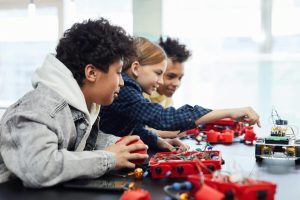Inclusive Classrooms: Strategies and Success Stories
Inclusive classrooms are a cornerstone of modern education. It is a concept that promotes diversity and inclusivity in the classroom, providing equal opportunities for all students to learn and thrive. Inclusive classrooms are not just about accommodating students with disabilities or special needs; they also celebrate and embrace differences in race, gender, socio-economic background, and learning styles. In this article, we will explore the strategies for creating inclusive classrooms and share success stories from educators who have implemented these strategies in their classrooms.
Understanding Inclusive Classrooms
Inclusive classrooms are built on the foundation of diversity, respect, and support. The goal is to create a safe and supportive learning environment where every student feels valued and included. In an inclusive classroom, students are encouraged to embrace their differences, learn from each other, and work together to achieve common goals. It is a collaborative and holistic approach to education that benefits all students, not just those with special needs.
Why Inclusive Classrooms are Important?
Inclusive classrooms have a profound impact on students’ academic, social, and emotional development. When students feel included and valued, they are more engaged in their learning and have a positive attitude towards school. Inclusive classrooms promote diversity and cultural understanding, preparing students to be global citizens. Moreover, students who learn in inclusive classrooms develop empathy, compassion, and respect for others, which are essential life skills.
Strategies for Creating Inclusive Classrooms
1. Inclusive Curriculum
The first step towards creating an inclusive classroom is to have an inclusive curriculum. Educators can create a curriculum that reflects diversity, incorporates various learning styles, and encourages critical thinking and problem-solving. An inclusive curriculum should also include materials that represent different cultures, races, and genders. This allows students to see themselves reflected in the curriculum and feel connected to their learning.
2. Flexible Learning Environment
Inclusive classrooms have a flexible learning environment that can accommodate the needs of all students. This may include having different seating arrangements, providing assistive technology or learning aids, and offering alternative assessment methods. A flexible learning environment also creates a sense of freedom and choice for students, which promotes autonomy and self-directed learning.
3. Differentiated Instruction
Every student learns differently, and differentiated instruction allows educators to cater to individual student’s needs. In an inclusive classroom, educators use a variety of teaching strategies and methods to ensure all students can access and understand the content. This may include visual aids, hands-on activities, and group discussions. When students feel that the learning is tailored to their needs, they are more engaged and motivated to learn.
Success Stories of Inclusive Classrooms
1. The Inclusive Classroom in Action
Karen is a teacher who has been implementing inclusive classroom strategies for five years in her 4th-grade class. She noticed that one of her students, who had difficulty reading, became disengaged and frustrated during reading activities. Karen started using an alternative approach, such as providing audio books and implementing small group reading sessions, which allowed the student to thrive and participate actively in class. She also created a buddy system, where students with different abilities were paired to work on projects together, promoting teamwork and collaboration.
2. A Diverse Curriculum for an Inclusive Classroom
Anna is an elementary school teacher who wanted to create a more inclusive curriculum for her 3rd-grade class. She incorporated more diverse literature, non-fiction texts on various cultures, and included projects that celebrated different festivals and traditions. The students were excited to learn about different cultures, and the project work fostered a sense of community and respect for diversity within the classroom.
3. Inclusivity for All Learners
Mark is a high school teacher who has been teaching in an inclusive classroom environment for ten years. He has seen the positive impact it has on all students, not just those with special needs. In his classroom, he encourages students to take on leadership roles and set personal goals for themselves. He also fosters an environment where students can express themselves freely and discuss social issues in a respectful manner. Mark has seen a significant improvement in student achievement, engagement, and self-confidence in his students over the years.
Conclusion
Inclusive classrooms are a testament to our commitment to diversity, equity, and fairness in education. By implementing these strategies and sharing success stories, we hope to inspire educators to create inclusive classrooms that celebrate and embrace differences, promote empathy, and support all students to reach their full potential.










